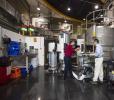
Working at ANSTO
ANSTO offers a diverse range of career opportunities within science, engineering, corporate services and trade disciplines.

Showing 261 - 280 of 505 results

ANSTO offers a diverse range of career opportunities within science, engineering, corporate services and trade disciplines.
Staff from ANSTO’s High Reliability team, Prashant Maharaj, Tina Paneras, and Sam Sonter were honoured to present at the International Atomic Energy Agency’s (IAEA) Train-the-Trainers Regional Training Course for Radiation Protection Officers in Vienna, Austria on 16 to 20 January 2023.
A number of sophisticated non-invasive nuclear and accelerator techniques were used to provide information about the origin and age of an Australian Aboriginal knife held in the collection of the Powerhouse Museum.
Charcoal particles from recent bushfires in NSW were carried 50 kilometres by the wind, which has significance for fire history reconstruction.
Monash University, University of Queensland and Australian National University researchers have used ANSTO’s Australian Synchrotron in their study of meteorites found on Earth that could be used in future to find evidence of life on the planet Mars.
Frequently Asked Questions on the Macromolecular Crystallography beamlines (MX1 and MX2)

You are invited to submit to the various awards from ANSTO and the User Meeting 2025 organising committee.
Phase contrast tomography shows great promise in early stages of study and is expected to be tested on first patients by 2020.
NSW grants bolster additive manufacturing and groundwater processing capabilities.

Currently ANSTO partners with the Australian Bureau of Meteorology to operate the Australian GNIP stations with samples analysed at ANSTO’s Environmental Isotope Laboratories in Sydney.

Micro-Particle Induced X-ray Emission (µPIXE) is used to construct elemental maps that show variations of an element's concentration across the sample surface.
International fusion researchers, including ANSTO’s Dr Richard Garrett, have recently returned from ITER in France where they attended a meeting of the coordinating committee of the International Tokomak Physics Activity (ITPA).
International fusion researchers recently returned from ITER in France where they attended a meeting of the coordinating committee of the International Tokomak Physics Activity.

Ultra small angle neutron scattering on Kookaburra is used to study the size and shape of objects of size 10 micrometres and below.